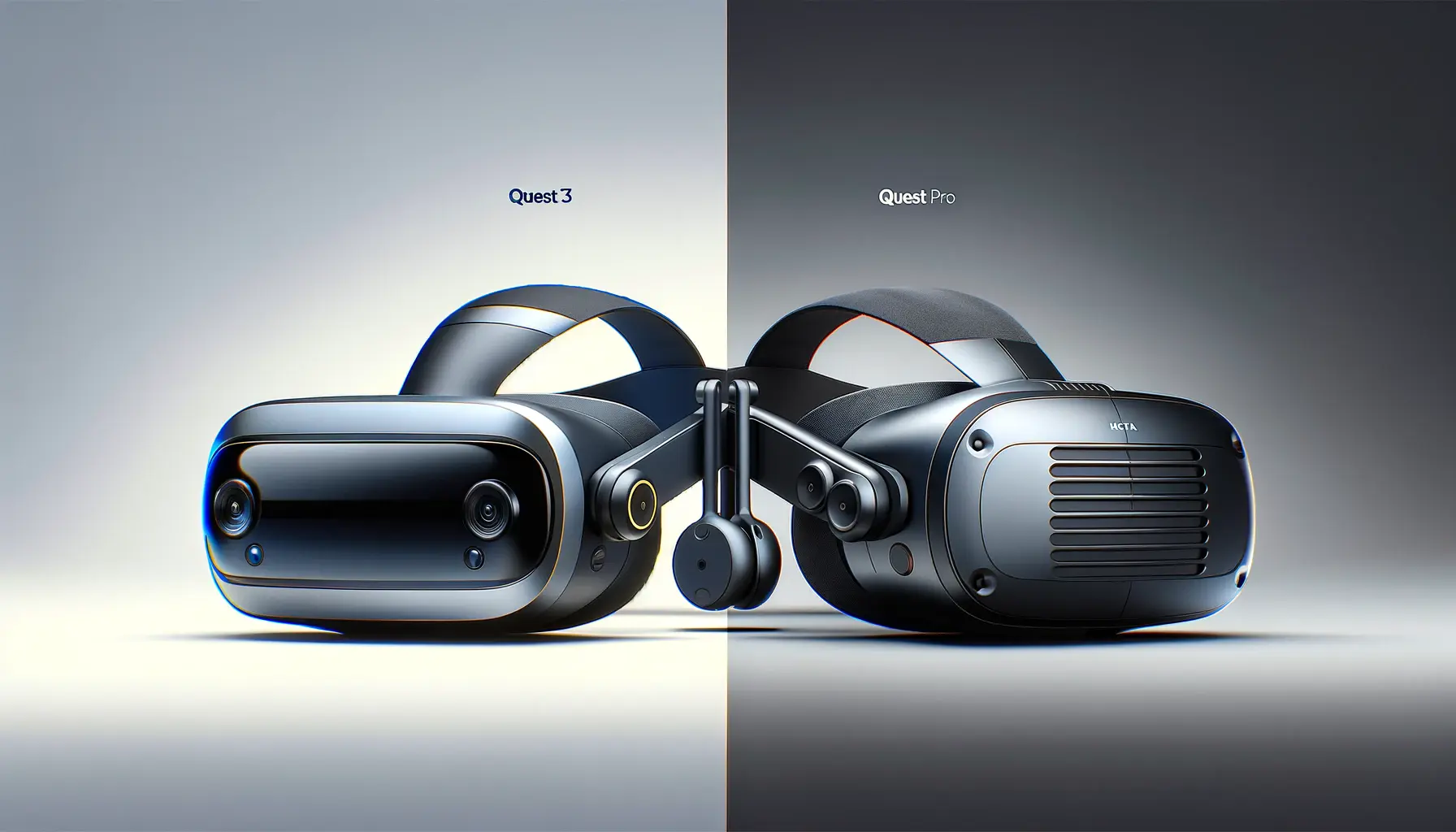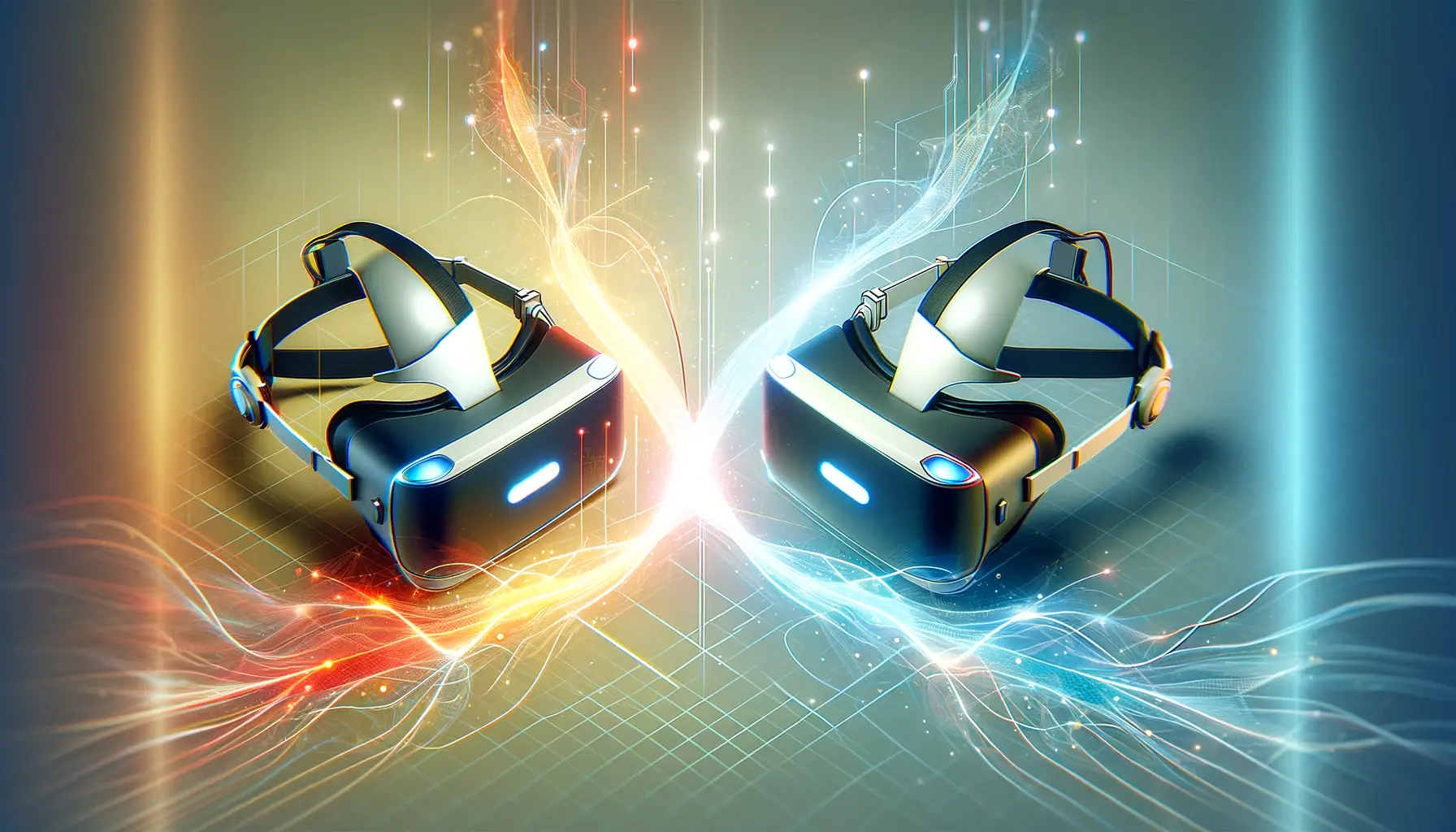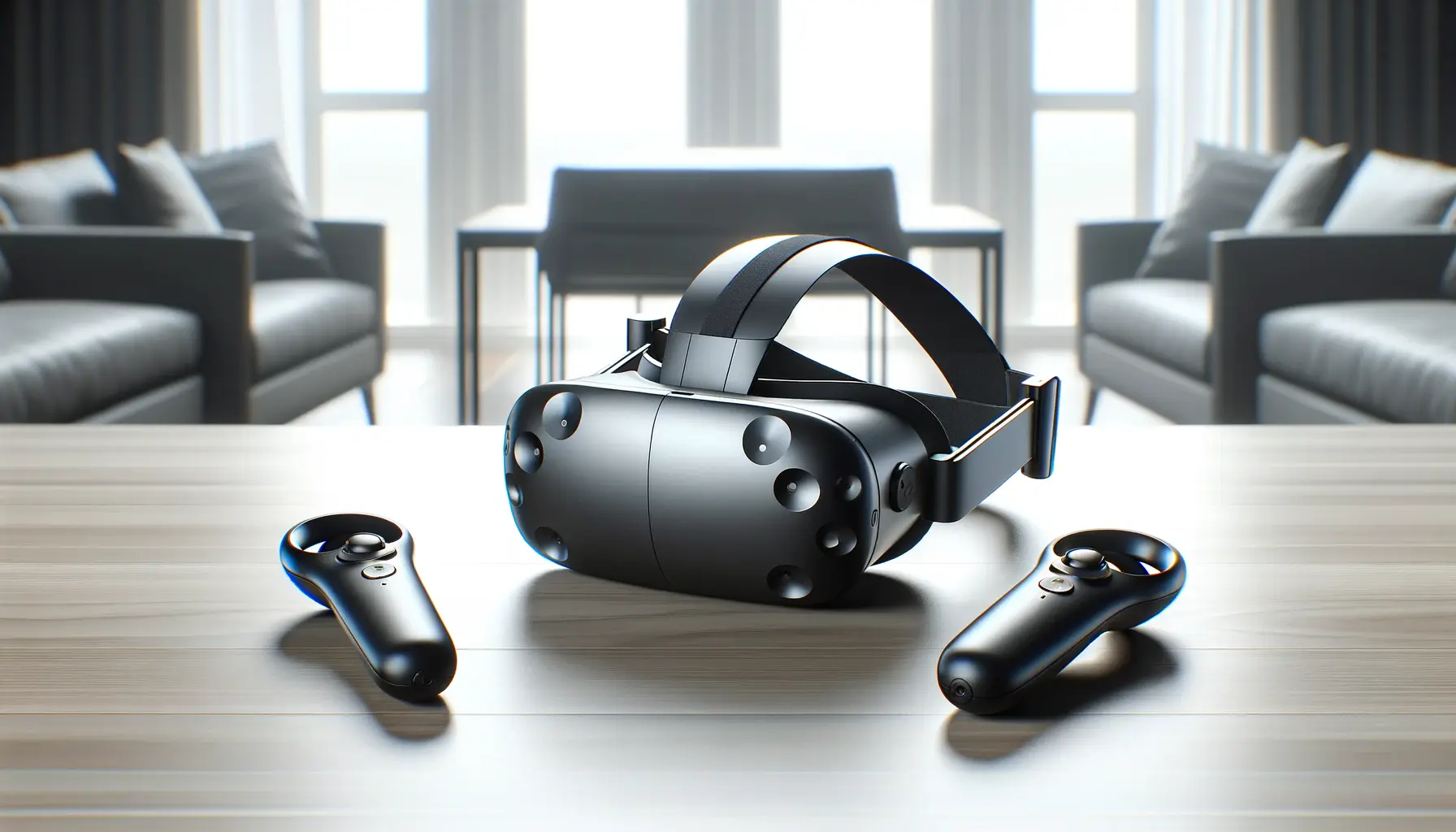The realm of virtual reality (VR) has been evolving at an unprecedented pace, with Meta Quest 3 emerging as a frontrunner in this technological race.
The controllers of Meta Quest 3, a pivotal component of this immersive experience, have garnered significant attention for their innovative design and functionality.
This article delves into the intricacies of these controllers, offering a comprehensive analysis that aims to enlighten both VR enthusiasts and newcomers alike.
Meta Quest 3’s controllers, known for their precision and ergonomic design, represent a leap forward in VR interaction.
As we explore these controllers, we’ll uncover the layers of technology and design philosophy that make them stand out in the competitive landscape of VR hardware.
The journey through the Meta Quest 3 controllers is not just about understanding a piece of hardware; it’s about appreciating the strides made towards more intuitive and immersive virtual experiences.
Design and Ergonomics
The design of the Meta Quest 3 controllers is a testament to Meta’s commitment to user comfort and immersive gameplay.
These controllers have been meticulously crafted to fit naturally in the hands of the user, reducing fatigue and enhancing the overall gaming experience.
The ergonomic design is not just about comfort; it’s a crucial factor in maintaining immersion, allowing players to engage with virtual environments for extended periods without discomfort.
One of the standout features of the Meta Quest 3 controllers is their lightweight construction, coupled with a balanced distribution of weight.
This design choice ensures that movements feel natural and responsive, a critical aspect when translating physical actions into virtual outcomes.
The controllers’ contours and button placement have been optimized based on extensive user feedback, ensuring that each interaction feels intuitive and accessible to gamers of all skill levels.
Advanced Haptic Feedback
The haptic feedback system in the Meta Quest 3 controllers takes virtual interactions to new heights.
By providing tactile responses to virtual actions, these controllers deliver a layer of realism previously unattainable in VR gaming.
Whether it’s the sensation of drawing a bowstring or the feedback from pressing a virtual button, the advanced haptics make each action feel tangible.
This immersive feedback is not just about enhancing gameplay; it’s a crucial component of the VR experience that helps bridge the gap between the virtual and the real world.
The nuanced vibrations and textures that the controllers can simulate add depth to virtual environments, making them more engaging and believable.
The Meta Quest 3 controllers are designed with an emphasis on ergonomics and advanced haptic feedback, elevating the VR experience by making virtual interactions feel more natural and immersive.
Tracking Technology and Performance
The tracking technology embedded within the Meta Quest 3 controllers is a cornerstone of their functionality, ensuring that every movement is captured with precision and accuracy.
This advanced tracking system allows for seamless integration of physical actions into the virtual world, providing a fluid and responsive experience that is essential for immersive VR gameplay.
At the heart of the controllers’ tracking capabilities is a combination of infrared LEDs and sensors that work in tandem with the headset to monitor the controllers’ positions in real time.
This setup not only enhances the accuracy of motion capture but also significantly reduces latency, making for a more reactive and engaging virtual environment.
Seamless Integration with VR Environments
The Meta Quest 3 controllers are engineered to work harmoniously with the headset, creating a unified ecosystem that enhances the VR experience.
This integration extends beyond mere tracking, incorporating:
- Gesture Recognition: The controllers can detect complex hand movements, allowing for more nuanced interactions within VR applications.
- Environmental Awareness: Advanced algorithms predict user intent, adjusting the virtual environment in real-time to match physical movements.
This seamless integration is pivotal in creating a cohesive and immersive VR experience, where the boundaries between the physical and virtual worlds blur.
Optimized for Extended Play
The performance of the Meta Quest 3 controllers is designed with longevity in mind, ensuring that they can withstand the rigors of extended play sessions.
This is achieved through:
- Energy-efficient design, maximizing battery life without compromising on responsiveness or functionality.
- Durable materials and construction, ensuring that the controllers can endure accidental drops and the wear and tear of regular use.
The combination of advanced tracking technology, seamless integration with VR environments, and optimization for extended play underscores the Meta Quest 3 controllers’ role in delivering a superior VR experience.
The integration of sophisticated tracking technology and the emphasis on durability and energy efficiency make the Meta Quest 3 controllers a pivotal component in the evolution of virtual reality gaming.
User Interface and Control Scheme
The Meta Quest 3 controllers are not just about physical design and tracking; they also boast an intuitive user interface and control scheme that cater to both seasoned gamers and VR novices.
This ease of use is critical in VR, where complex interactions need to be executed smoothly to maintain immersion.
The controllers feature a thoughtful arrangement of buttons, triggers, and joysticks, designed to provide quick access to common functions without overwhelming the user.
This layout supports a wide range of interactions, from simple navigation through menus to complex in-game actions, ensuring that users can adapt quickly regardless of their experience level with VR technology.
Customization and Accessibility
Understanding that no two users are the same, Meta has incorporated various customization options into the Quest 3 controllers.
These features include:
- Adjustable sensitivity settings for the triggers and joysticks, allowing users to tailor the controllers’ responsiveness to their preferences.
- Configurable button mappings, enabling users to set up control schemes that best suit their play style or accessibility needs.
This focus on customization and accessibility ensures that the Meta Quest 3 controllers can provide a comfortable and enjoyable experience for a broad audience, including those with limited mobility or other accessibility requirements.
Feedback and Interaction Enhancements
Beyond the physical inputs, the controllers are equipped with features that enhance feedback and interaction within VR environments:
- Voice commands integration, offering an alternative way to interact with virtual worlds and navigate menus.
- Touch-sensitive surfaces that detect varying degrees of pressure, adding another layer of depth to VR interactions.
These enhancements contribute to a more dynamic and engaging user experience, allowing for a greater degree of control and immersion in virtual environments.
The Meta Quest 3 controllers’ user-friendly interface, combined with extensive customization options and innovative interaction enhancements, set a new standard for VR controller design.
Compatibility and Connectivity
The Meta Quest 3 controllers are designed with a forward-thinking approach to compatibility and connectivity, ensuring they seamlessly integrate with existing and future VR ecosystems.
This compatibility is crucial for users who wish to use their controllers across a range of VR applications and games, maximizing their investment in the Meta Quest platform.
At the core of the controllers’ connectivity features is Bluetooth technology, which facilitates a reliable and quick connection to the Meta Quest 3 headset.
This wireless connectivity not only eliminates the hassle of tangled wires but also provides the freedom to move without restrictions, a necessity for an immersive VR experience.
Interoperability with Other Devices
Beyond the Meta Quest ecosystem, the controllers are designed to be interoperable with other devices, enhancing their utility and flexibility.
Key aspects of this interoperability include:
- Support for PC connectivity, allowing users to play a wider range of VR games and applications beyond those available on the Meta Quest platform.
- Compatibility with certain mobile apps, enabling the use of the controllers for navigation and interaction within mobile VR experiences.
This broad compatibility ensures that the Meta Quest 3 controllers remain versatile and functional across different platforms and use cases.
Software Support and Updates
Meta recognizes the importance of software in enhancing the functionality and longevity of their controllers.
As such, the company provides:
- Regular firmware updates to improve tracking accuracy, battery life, and overall performance.
- Software development kits (SDKs) for developers, encouraging the creation of new games and applications that leverage the unique features of the Meta Quest 3 controllers.
Through ongoing software support and updates, Meta ensures that the Quest 3 controllers continue to evolve, offering new features and improvements that enhance the VR experience over time.
The Meta Quest 3 controllers’ emphasis on compatibility and connectivity, coupled with robust software support, underscores Meta’s commitment to providing a versatile and future-proof VR experience.
Immersive Gaming Experiences
The Meta Quest 3 controllers are engineered to elevate immersive gaming experiences, serving as the bridge between the player and the virtual world.
Their advanced features and capabilities are designed to enhance the sense of presence within a game, making virtual experiences feel more real and engaging.
Through precise tracking, intuitive controls, and immersive feedback, these controllers allow players to interact with virtual environments in ways that were previously unimaginable.
Whether it’s wielding a sword, drawing a bow, or solving puzzles, the Meta Quest 3 controllers make every action feel impactful and authentic.
Enhanced Interaction in Virtual Worlds
The controllers’ ability to accurately translate physical movements into virtual actions is pivotal for immersive gameplay.
This enhanced interaction is made possible through:
- High-fidelity tracking that captures even the subtlest movements, allowing for nuanced interactions within games.
- Dynamic haptic feedback that provides tactile sensations corresponding to in-game actions, further blurring the line between the virtual and the real.
These features combine to create a deeply immersive gaming experience, where players can lose themselves in the virtual worlds they explore.
Support for a Wide Range of Genres
The versatility of the Meta Quest 3 controllers extends to their support for a wide range of game genres, from fast-paced action and adventure to strategic puzzles and simulations.
This versatility is achieved through:
- Adaptable control schemes that can be customized to suit the specific needs of different game types, ensuring optimal gameplay regardless of the genre.
- Developer tools and APIs that enable game creators to integrate the unique features of the controllers into their games, allowing for innovative gameplay mechanics.
This broad support not only enriches the gaming library available to Meta Quest 3 users but also encourages developers to push the boundaries of VR gaming.
The Meta Quest 3 controllers are at the forefront of immersive gaming, offering unparalleled interaction and support across a diverse array of game genres, thus redefining the VR gaming landscape.
Future Developments and Innovations
The Meta Quest 3 controllers represent a significant milestone in VR technology, but they are just the beginning of a journey towards even more immersive and intuitive virtual experiences.
Meta is committed to continuous innovation, with plans to introduce new features and improvements that will further enhance the capabilities of their controllers.
Looking ahead, future developments are expected to focus on increasing the realism of virtual interactions, reducing latency, and improving the overall user experience.
These innovations will not only make VR more accessible to a broader audience but also open up new possibilities for applications beyond gaming, such as education, training, and virtual collaboration.
Advancements in Haptic Technology
One area of focus for future development is the advancement of haptic technology.
Meta aims to:
- Introduce more nuanced and varied haptic feedback, allowing users to feel a wider range of textures and sensations.
- Develop haptic gloves or wearables that could complement or even replace traditional controllers, offering a more natural way to interact with virtual environments.
These advancements in haptic technology promise to make virtual experiences even more tactile and engaging, further closing the gap between the virtual and the real world.
Enhancing Tracking Accuracy and Efficiency
Another key area of innovation is the enhancement of tracking accuracy and efficiency.
Future versions of the Meta Quest controllers may feature:
- Improved sensor technology for even more precise and responsive tracking.
- Machine learning algorithms that predict user movements, reducing latency and improving the fluidity of interactions.
By enhancing tracking accuracy and efficiency, Meta aims to provide users with a more seamless and immersive VR experience, where actions in the virtual world feel as natural and intuitive as those in the real world.
The future of Meta Quest 3 controllers is bright, with ongoing developments in haptic technology and tracking accuracy poised to revolutionize the way we interact with virtual environments.
Community and Developer Support
The success of the Meta Quest 3 controllers extends beyond their technological advancements; it also lies in the vibrant community and robust developer support that surrounds them.
Meta has cultivated a thriving ecosystem where users and developers alike can share experiences, offer feedback, and contribute to the platform’s growth.
This collaborative environment is crucial for the continuous improvement and innovation of VR technologies.
Meta’s commitment to community engagement is evident in their forums, social media channels, and developer conferences.
These platforms provide valuable opportunities for users to voice their opinions, report issues, and suggest improvements, ensuring that the controllers evolve in ways that meet the community’s needs.
Resources for Developers
To empower developers to create compelling content for the Meta Quest 3, Meta provides a wealth of resources, including:
- Comprehensive software development kits (SDKs) that offer tools and documentation for integrating controller features into VR applications.
- Access to beta features and APIs, allowing developers to experiment with new functionalities and provide feedback before they are widely released.
These resources not only facilitate the development of innovative VR experiences but also encourage a culture of experimentation and creativity within the developer community.
Expanding the VR Ecosystem
The support for developers is part of Meta’s broader strategy to expand the VR ecosystem.
By fostering a diverse range of applications and experiences, Meta aims to:
- Attract a wider audience to the VR platform, including users who may not traditionally be interested in gaming.
- Explore new use cases for VR technology, such as virtual meetings, education, and training simulations, further solidifying VR’s role in our digital lives.
This expansion of the VR ecosystem is essential for the long-term success and relevance of the Meta Quest platform, ensuring that it remains at the forefront of digital innovation.
Through active community engagement and comprehensive developer support, Meta is not just advancing the capabilities of the Quest 3 controllers but also shaping the future of virtual reality as a whole.
Embracing the Future with Meta Quest 3 Controllers
The journey through the capabilities, design, and potential of the Meta Quest 3 controllers underscores a pivotal shift in virtual reality technology.
These controllers are not merely peripherals; they are the heart of the VR experience, enabling users to step into new worlds with unprecedented ease and immersion.
As we’ve explored, from their ergonomic design to the advanced haptic feedback, tracking accuracy, and seamless integration with the VR ecosystem, the Meta Quest 3 controllers stand as a testament to Meta’s vision for the future of digital interaction.
The Path Ahead
The continuous evolution of the Meta Quest 3 controllers, driven by technological innovation and community feedback, highlights Meta’s commitment to refining the VR experience.
The future developments in haptic technology and tracking accuracy promise to further blur the lines between the virtual and the real, opening up new possibilities for interaction and immersion.
Moreover, the emphasis on developer support and the expansion of the VR ecosystem reflect a broader strategy to make virtual reality a staple in entertainment, education, and beyond.
A Foundation for Growth
The Meta Quest 3 controllers are more than just an interface for virtual worlds; they are a foundation upon which the future of VR will be built.
With each update and innovation, Meta not only enhances the capabilities of these controllers but also enriches the VR landscape, inviting users and developers to explore the potential of virtual reality together.
The journey of the Meta Quest 3 controllers is far from over, and we can expect to see them continue to evolve, shaping the future of VR for years to come.
- The ergonomic design and advanced haptic feedback of the controllers enhance user comfort and immersion.
- Tracking technology and seamless integration with VR environments ensure a fluid and responsive experience.
- Compatibility and connectivity with a wide range of devices and platforms make the controllers versatile and future-proof.
- Support for immersive gaming experiences across various genres showcases the controllers’ adaptability and potential for innovation.
- Future developments promise to introduce even more realistic interactions and improved performance.
- Community and developer support play a crucial role in the continuous improvement and expansion of the VR ecosystem.
In conclusion, the Meta Quest 3 controllers are at the forefront of virtual reality’s march towards mainstream adoption.
Their design, functionality, and the promise of future innovations not only enhance the VR experience but also pave the way for new applications of virtual reality technology.
As Meta continues to push the boundaries of what’s possible in VR, the Meta Quest 3 controllers will undoubtedly play a central role in defining the future of digital interaction.
Meta Quest 3 Controllers FAQ
Explore the most common inquiries about the Meta Quest 3 Controllers to enhance your VR experience.
Ensure your headset is powered on, then press the power button on each controller to initiate pairing.
Yes, third-party attachments compatible with the controllers’ design can be used to enhance your VR experience.
Yes, Meta Quest Touch Plus controllers can be purchased separately as an additional accessory.
Currently, Quest 3 Controllers are only compatible with the Quest 3 headset, not Quest 2.
They feature a compact design, realistic sensations, and new levels of interaction for an immersive experience.
While theoretically possible, Quest 3 controllers are currently not compatible with Quest 2 headsets.
Key features include advanced tracking, ergonomic design, and immersive haptic feedback for a superior VR experience.
Comprehensive guides are available online, detailing setup, usage, and troubleshooting for optimal performance.














